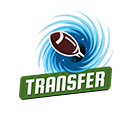On the latest episode of The Three Technique, we broke down a tidal wave of transfer portal entries with Jake Slauer. One of the biggest items we discussed was the sustainability of the current system. Upon the opening of the portal, ESPN counted 1,190 players who put their name into the system. A good number grabbed headlines as players like Dillon Gabriel (Oregon), Riley Leonard, Walter Nolen, Andrew Mukuba and more have gone into the portal.
That number has continued to climb throughout the past week, with hundreds of new players appearing in the portal over the last few days. Rosters are in upheaval ahead of bowl season; new coaches find themselves recruiting their own roster more than the high school ranks ahead of December’s signing day. It’s total madness…but is it helpful for the sport?
A Risky Investment
While the casual sentiment is that players who enter the portal are simply seeing if they can get a better NIL deal or find a starting spot, the numbers bear out a far more serious risk/reward calculation that each player should run before making this decision.
Per Sports Illustrated, between 2022 and 2023, only 54% of players who entered the portal found a new school. 41% of players either got stuck looking, transferred to a non-NCAA school, or left the sport entirely. Almost 10% of players forfeited their scholarships and walked-on at a new school. The worst number? 33% of players did not find a new destination to play.
Is It Sustainable?
One of the biggest questions we have going forward regards the sustainability of the portal. With rosters turning over every offseason and the coaching staff working 25-hour days just to keep their players out of the portal, we worried about the development of players and rosters overall (around the 13-minute mark).
Not only is it an issue from the player development perspective, boosters are also feeling the heat. NIL funds have never been more important than they are today, and yet the current system operates like the boosters are working a printing press five days a week. Smaller schools struggle to keep up with the demand year over year. While year one might have been exciting and new, in the current state, there are just a handful of schools who “might” be able to keep up.
What’s The Solution?
Everyone can point out a problem, but few can provide a solution. The NCAA certainly screwed up when it opened up the transfer portal and NIL without any real guidelines. But with the toothpaste out of the proverbial tube, there appear to be two main options.
First, and what the NCAA is currently attempting to do, is build the plane while it’s in the air. We’ve seen adjustments to the portal window, scholarship amounts, official visits, and more since the portal began churning. The problem? Issues are arising faster than the NCAA can meet and solve for them. Tampering is currently a HUGE issue. I’ve had multiple writers/insiders confirm that NIL offers are back channeled to players on other rosters long before the communication window opens. Enticement and “pay for play” strategies are on the rise. I doubt the NCAA can implement new regulations fast enough to stop them at this point.
The second avenue completely eradicates the amateur nature of the collegiate game…although I think we can all agree that it eroded a long time ago. Collective bargaining would provide the athletes with a piece of the gigantic media rights deals that Fox, ESPN, and CBS have all been bartering for over the last several decades. By creating a collective bargaining agreement, the majority of athletes wouldn’t need to hop from school to school looking for NIL deals. Instead, they would all receive a piece of the pie.
“What about the stars?” You might ask. “Shouldn’t they get a bigger piece for being a contender for the [insert award here]?” That’s a great question, one that the NCAA would certainly have to iron out if it chose to go down this route. Still, a CBA could provide the most level playing field for all schools and athletes, instead of the ones with the biggest donor bases.







